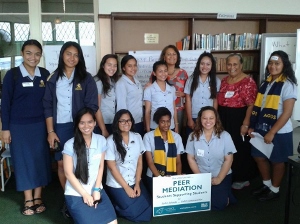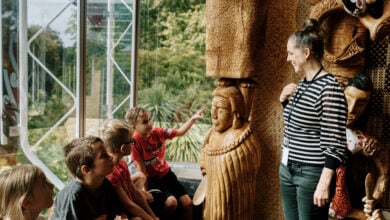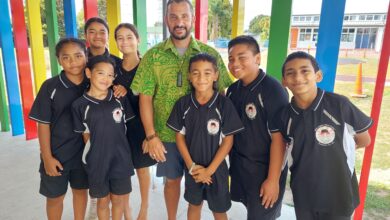Anti-Bullying

 While students, parents and teachers have been dealing with school bullying for decades, it’s only over recent years that media coverage has brought it to the attention of the wider public.
While students, parents and teachers have been dealing with school bullying for decades, it’s only over recent years that media coverage has brought it to the attention of the wider public.
Stories of teens hounded by their peers to the point of suicide, though fortunately rare, have raised awareness of the dangers of bullying which, even if it doesn’t end in tragedy, nevertheless can make a child or young person’s life utterly miserable.
Bullying can generally be defined as repeated behaviour that causes harm to another individual or group of individuals. It can involve teasing; spreading gossip, isolation or physical attacks, but now, according to representatives of organisations offering anti-bullying programmes in New Zealand schools, social media in its various forms is creating even more bullying opportunities.
“Social media has changed the bullying landscape,” Marion Short of the Foundation for Youth says. “Young people can’t get away from it. Before, they could leave school and go home and be free of it, but now they can’t.”
The Peace Foundation’s Christina Barruel agrees that with the advent of social media, bullying is a lot more prevalent, with victims being targeted intentionally and indirectly.
Lisa Piper of Kidpower points out that a perception that bullying occurs mostly in lower socio-economic areas is a myth and that in fact, it occurs in all schools. “Children from all walks of life have a far greater access to social media, which means bullying is not just isolated to school. Social media is making bullying more accessible to more children because they can hide behind a screen of some kind,” Ms Piper says.
However, according to a Victoria University report released in April 2013, an online survey that 860 New Zealand schools completed and 1236 schools partially completed (all schools were invited to participate), traditional forms of bullying were still the most prevalent. Social/relational bullying was seen as a problem by 70 per cent of respondents, and 67 per cent agreed that verbal bullying was a problem. By contrast, only 39 per cent agreed that cyberbullying and 35 per cent that physical bullying was a problem.
But whatever form it takes, bullying is recognised as an issue that has to be addressed if we want our students to face life confidently and get maximum benefit from their schooling. The three organisations spoken to by School News offer a range of programmes and tools designed to equip children and teenagers with the skills to handle any type of conflict, harassment or aggressive behaviour they may encounter, in or out of school.
The Peace Foundation’s Cool Schools was piloted as a primary school programme in1992, and then extended into secondary schools in the mid-1990s. The secondary programme is now called LtPM (Leadership through Peer Mediation). Kia Tau te Rangimarie is the new Maori programme for Te Reo full immersion Maori schools or mainstream schools with a high percentage of Maori students on their roll.
“With these peace education programmes we equip students and teachers with skills to build positive relationships, especially in times of conflict. The benefits are lifelong. Empathy and empowerment are core values promoted in our programmes, the foundation’s head of education, Ms Barruel says.
“If cyberbullying is an issue we refer schools to Netsafe. This is their expertise. We’re more about giving students and staff a toolbox of skills so when they’re faced with a situation where they’re being hassled, or there’s conflict, they know how to deal with it in a constructive way.
“We believe it’s important conflict situations are dealt with in the early stages. Student peer mediators assist in nipping ‘small stuff’ behaviour in the bud before it escalates into ‘bigger stuff’.”
The leadership through peer mediation is a key aspect of the school programmes. Student mediators are trained to be facilitators of a problem-solving process, which encourages peers in conflict to reach their own solution to a problem,” Ms Barruel says.
“The mediators are fair and non-judgmental. They help their peers overcome minor problems without teacher intervention. If it’s a bigger problem, they know to refer this to an appropriate adult within the school. Secondary peer mediators often work closely with their school’s guidance counsellor.”
Ms Barruel says for a school’s programme to be effective, the school is advised to plan and implement a policy around school safety, relationship management, non-violence, anti-bullying and anti-harassment.
“There needs to be steps in place so everyone in the school community: parents, students and teachers, are on the same page. I make this very clear in the staff training.”
Since the government launched the website wellbeing@school, which also provides tools, resources and services, we’re finding more schools are being pro-active in keeping their environment safe. This includes dealing with any bullying issues,” Ms Barruel says.
Founded in 1995 as the Project K Trust, The Foundation for Youth Development’s (FYD) Kiwi Can programme runs weekly classes for around 13,000 year 1-8 children in primary and intermediate schools across New Zealand every year.
FYD focuses on lower-decile schools, but welcomes schools across the board to become involved, the foundation’s CEO Ms Short says. To have the Kiwi Can programme provided, schools need to have a dedicated classroom available where the trained Kiwi Can leaders run the weekly high-energy, age-appropriate Kiwi Can classes.
“That way, Kiwi Can becomes an integral part of the school. The whole school is involved. We’ve found that the schools which benefit the most from the programme are those that embrace Kiwi Can.”
The Kiwi Can classes have been shown to “significantly reduce bullying”, she says.
“Principals tell us time and time again that how the kids play with each other has vastly improved, and we hear it from the children as well. They’re all getting the same message and they’re talking to each other about what they’ve learnt.”
As one principal puts it: “We had previous ERO reports that had identified that bullying was an issue in our [school]. Since we have had Kiwi Can, the bullying has almost been eliminated. And the behaviour of the students has been great.”
“The biggest thing with Kiwi Can,” Ms Short says, “is equipping young people to have resilience to deal with what comes across their path. It’s about building resilience and teaching good values. The added value is that the resulting positive behaviour supports learning.
“Another positive result of Kiwi Can is that it is also reducing the incidence of truancy, with children wanting to be at school on Kiwi Can class days.”
Kidpower Teenpower Fullpower Trust NZ (Kidpower) is part of Kidpower Teenpower Fullpower International, a non-profit organisation that has been in operation since 1989. Its anti-bullying initiatives take the form of interactive workshops, which are predominately for primary schools catering for year 0-8 students but are available to people of all ages, says workshop facilitator Lisa Piper.
“With our workshops we help both the ones who are doing the bullying and the ones being bullied,” Ms Piper says. “What we’ve found is the children who are bullying others have often been bullied themselves, by sibling, peers or adults. The sad truth is a lot of children experience abuse and/or neglect.
“Bullying is about who has the power. Children who are bullying others often have low self-esteem and don’t know better ways to relate. In their world you’re either at the giving or the receiving end.”
Ms Piper believes the ones doing the bullying need as much help as the victims.
“In our workshops we change the children’s perception and give them experiences in how to be powerful as people who neither give nor take violence and bullying.
Practices and role plays are used to teach children the most appropriate way to deal with difficult situations,” she says.
“A practical skill children learn to use is ‘stop power’ – a hand gesture and raised voice, which can be enough to deflect unwanted behaviours,” Ms Piper says.
“They can also use ‘walk away power’ to take themselves out of the situation and join another group of children or go and talk to a teacher or a trusted adult.
“They are also taught to use their brain, body and voice power. When they take control of these three things, the power they already have improves the way they relate to others immensely.
“The important thing is that children practise skills during the session and in everyday life. We go back after a period of time and see if the children can demonstrate the skills and have used the resources we leave there. It’s an opportunity for us and their school to monitor real progress.”
In Auckland, children and schools are offered the incentive of a trip to Rainbow’s End if they can show they’ve made progress.
“At Kidpower we say it’s all about the progress, not perfection,” Ms Piper says.









